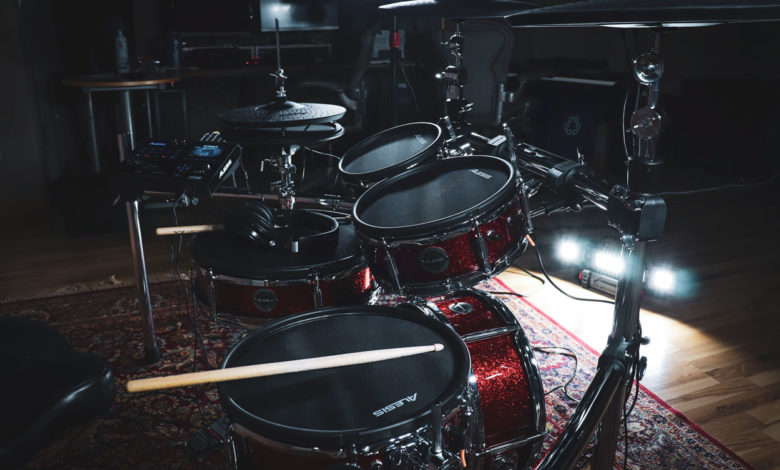
We may earn a commission from the affiliate links on this site. Learn more›
The Strike Pro is the flagship electronic drum kit sold from Alesis. It comes standard with eleven pieces and
With such an attractive price point when compared to the higher-end models from Roland, does the Strike Pro stand up to the competition? I believe it does, but there are some negative aspects to having such a low cost.
Alesis Strike Pro SE – My Review
Excellent alternative to Roland’s expensive kits.
Alesis has managed to create an electronic drum set that is both affordable and high quality. You won’t see specs like this on any other kit within its price range.
The kit looks amazing and the shells are sized just like a regular acoustic drum set would be.
Alesis just released the Strata Prime, featuring a revolutionary new drum module—check out my review here.
The Strike Pro kit recently made it into our roundup article on the best electronic drum sets. Let’s now dive deep on the kit on the good and bad.
Overview
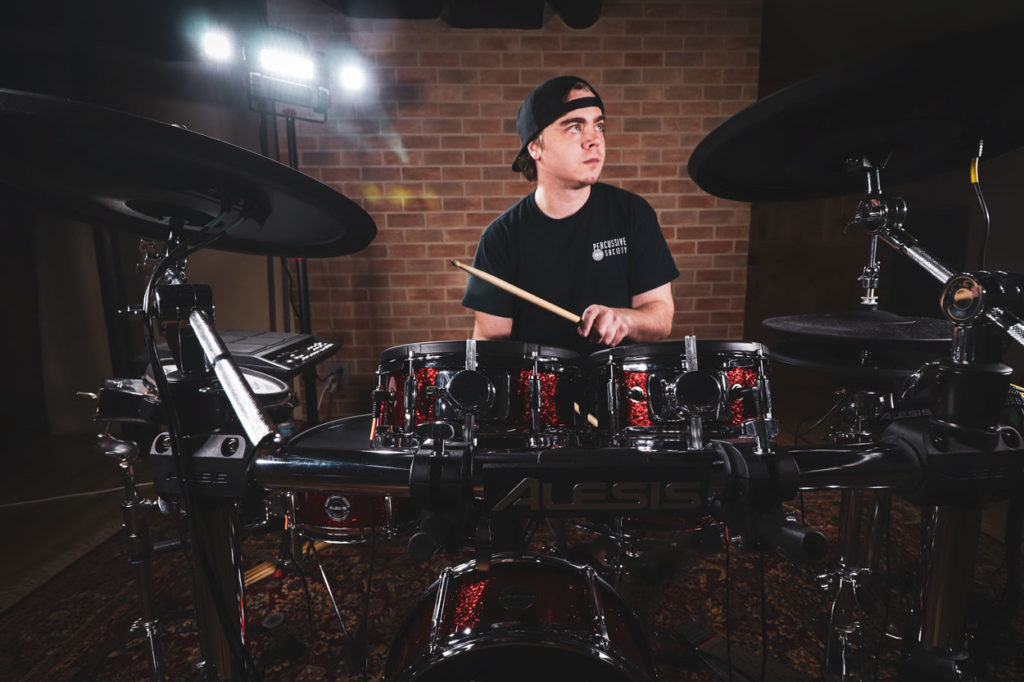
The Alesis Strike Pro is a professional electronic drum kit that comes with four tom pads, a snare pad, kick pad, four crash cymbals, and a hi-hat controller.
The pads are made from nylon mesh, which is the standard for most electronic kits these days.
Note: the kit mentioned in the article is the higher-end model of the Strike, though I own the regular Strike kit with one less pad and two
Included also is the Strike module that has a sleek design with faders, an LCD screen, and buttons to control parameters. The module comes pre-loaded with over 1600 multi-sampled instruments.
By all means it’s a solid drum kit.
What’s in the box?
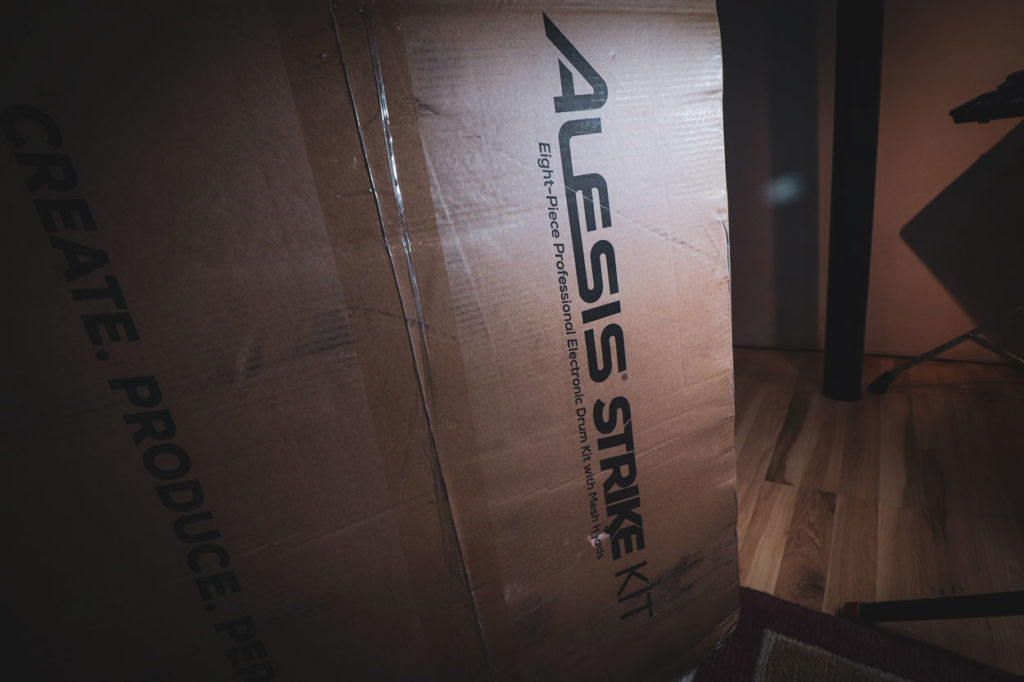
The kit itself is fairly large, so you’ll need a bit of time set aside to set it up prior to playing.
The box the Strike comes in is very heavy, so if you have stairs, you may have to unpack the boxes outside and bring them in seperately.
Included in the box is as follows:
- 14″ kick drum pad (1)
- 14″ dual-zone snare drum pad (1)
- 8″, 10″, 12″, 14″ dual-zone tom pads (4)
- 16″ triple-zone ride cymbal pad (1)
- 14″ dual-zone crash cymbal pads (2)
- 12″ hi-hat cymbal pads (1)
- Chrome rack (1)
- Strike drum module (1)
- Pair of drum sticks (1)
- Cable snake and wraps (1)
- Drum key (1)
- Power supply (1)
- Assembly guide (1)
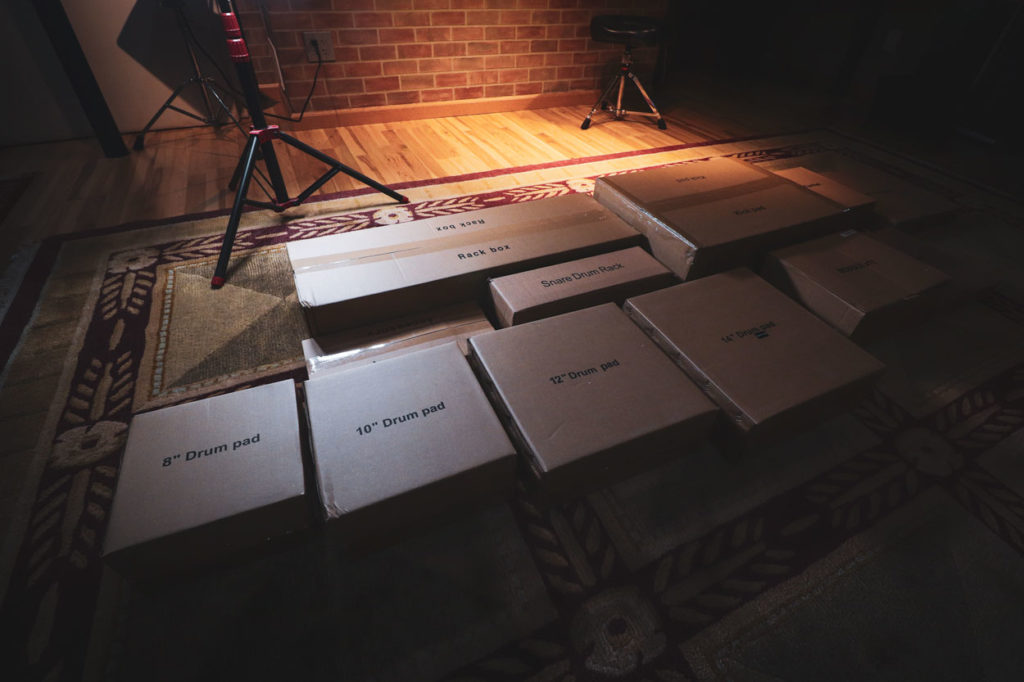
One big downside to buying the Strike Pro is the fact that you have supply your own kick pedal and hi-hat stand. The pedal is no problem for me, but I think they should supply some sort of hi-hat stand honestly.
Differences between the eleven and eight-piece kits
The eight-piece kit is significantly cheaper than the
The smaller Strike kit is expandable to the Pro version if you decide to upgrade at a later date.
Features
Let’s get into some of the top features.
- Strike Performance drum module equipped with a 4.3″ full-color LCD screen
- 110 kits and over 1,600 multi-sampled instruments
- 8GB SD card
- Dual-hoop pads with wooden shells
- 4-Post chrome rack
- Software editor
- On-board sampling capability
- USB/MIDI output for use with VST instruments
Traditional Drum Shell Sizes
Electronic drums often get a bad rap for being small and compact. A kit like the Alesis Nitro is so small that it can be tough to transition back to an acoustic kit.
The Strike Pro features regular shell sizes, meaning your acoustic kit and electronic kit should feel pretty similar in terms of ergonomics.
I’m a big fan of this, as I hated my Yamaha DTX drum kit in college. I found that the pads were too small and didn’t feel anything like a real drum set (not that they should).
It was nice for practicing, but if I had the choice all those years back to get the Strike kit, I would have.
The Look of the Shells
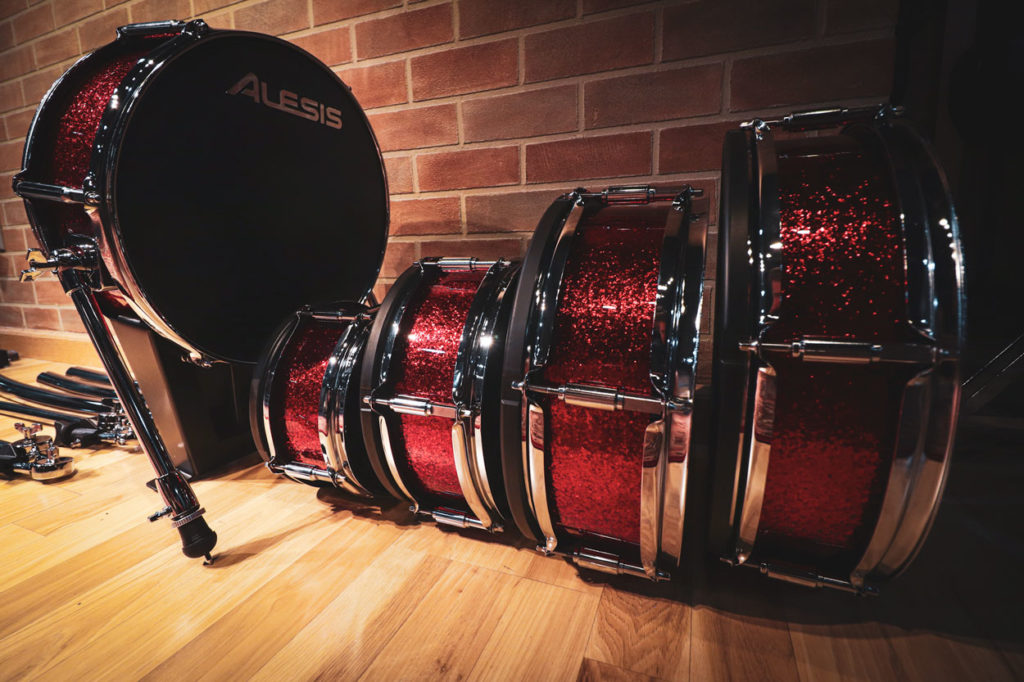
The shells themselves are made from wood and feature a beautiful red sparkle finish. “Real” drum shells are only available normally on kits like V-Drums or ATV Artist standard drums.
The Feel of the Strike Pro
As stated before, the kit feels very similar to that of an acoustic drum kit. The size is a big factor, but the mesh heads also help.
I’ve commented on mesh drum pads before, stating that they can give a false sense of what a drum feels like, but I really do enjoy the sensation of playing mesh heads.
The response is excellent and is exactly the case with this kit.
Roland’s pads are on the extreme end (very responsive) of the spectrum and older rubber pads (firm) on the other.
Alesis manages to land right in the middle: not too bouncy and not too rigid. The head tensions are adjustable to your liking, as well!

I believe the only way you can ever get close to the same feel as an acoustic kit is to actually convert your acoustic kit into an electronic kit using triggers.
While this requires a DIY approach (or by buying a full-fledged converted drum set), it could pay off for the end result.
Justin from 65 Drums has an excellent video explaining how to convert your acoustic drum set to electronic.
I’m not ready for the full-on conversion, so I went with a regular e kit for now.
The drum pads
Including a 14″ dual-zone snare drum pad was a great idea from Alesis. I honestly hate electronic kits that have a small snare drum.
It’s not because I can’t play in the center of the drum, rather, I just love emulating the feeling of sitting at a real drum kit.
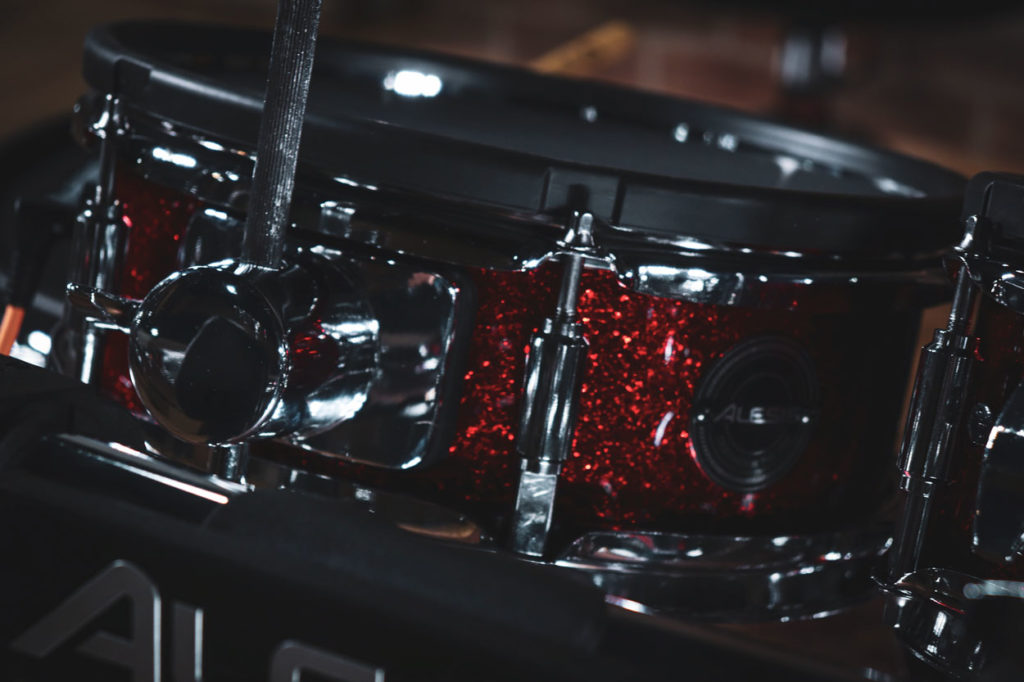
All included drum pads are dual-zone, which allows you to play independent sounds from both the pad itself and the rim.
This adds another level of realism that many entry-level kits will lack.
Tunable pads
The drum pads on the Strike kit are tunable, giving you the option to increase or decrease the responsiveness of the mesh heads.
I love this feature. It once again brings out the realness factor when comparing back to an acoustic drum set.
Great “looking” electronic cymbals
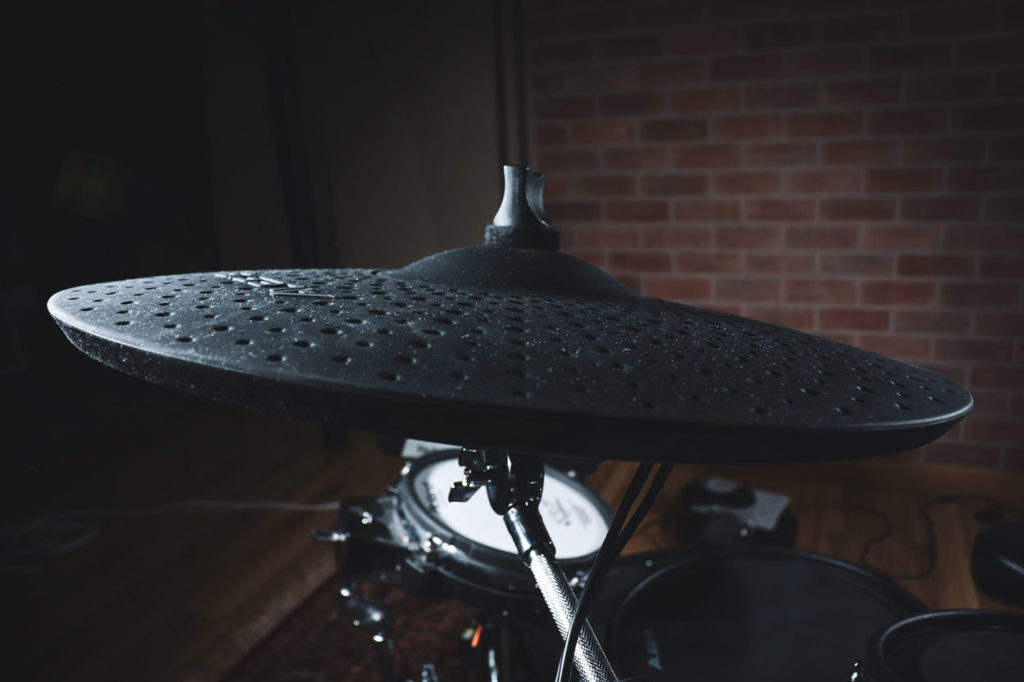
Upon first glance, the cymbals provided have a neat “hammered” look, emulating traditionally hand-hammered cymbals. It’s a nice touch.
The larger-sized bell is also great for playing different accents throughout a piece of music. All cymbals also feature the ability to be choked.
My big issue with these cymbals is only one side has the piezo; your cymbal must face a certain way, with the Alesis logo furthest away.
This isn’t a huge deal since there are locking washers under the cymbals keeping them straight.
My issue lies in the crash. The cymbal seems to misfire often when I’m not perfectly within the zone of the piezo.
Triple-zone ride cymbal and dual-zone crashes
The Strike Pro includes a triple-zone ride cymbal, which is something usually reserved, again, for higher-end e kits.
You’re able to hit either the bell, bow, or edge of the cymbal.
All the other cymbals included are only dual-zone. Including all triple-zone cymbals would take this kit to the next level, but for now, I find the cymbals to be great.
The drum module of the Strike Pro

The included module of the kit looks beautiful from a design standpoint. It’s got most of the bells and whistles that of the TD-50.
The drum module comes packed with 100 new drum kits and over 1,600 multi-sampled instruments.
Multi-sampled kits
Multi-sampled kits make electronic drums sounds more realistic.
For example, a lightly tapped snare might be from a collection of different samples than hitting the drum at full velocity.
This is what makes a kit sound realistic and not sound like a machine gun.
I’ve been a big critic of Alesis drum kits in the past when referring to multi-sampled drum kits. Their entry-level e kits don’t feature this type of technology and the sounds produced from those kits suffers.
I don’t believe those kits really need multi-sample technology, though it would be nice.
The only way to work around it is to use virtual instruments, like GetGood Drums to get a multi-sampled velocity drum kit out of an entry-level kit.
Enough of my sidetracking, back to the Strike Pro.
4.3″ color display
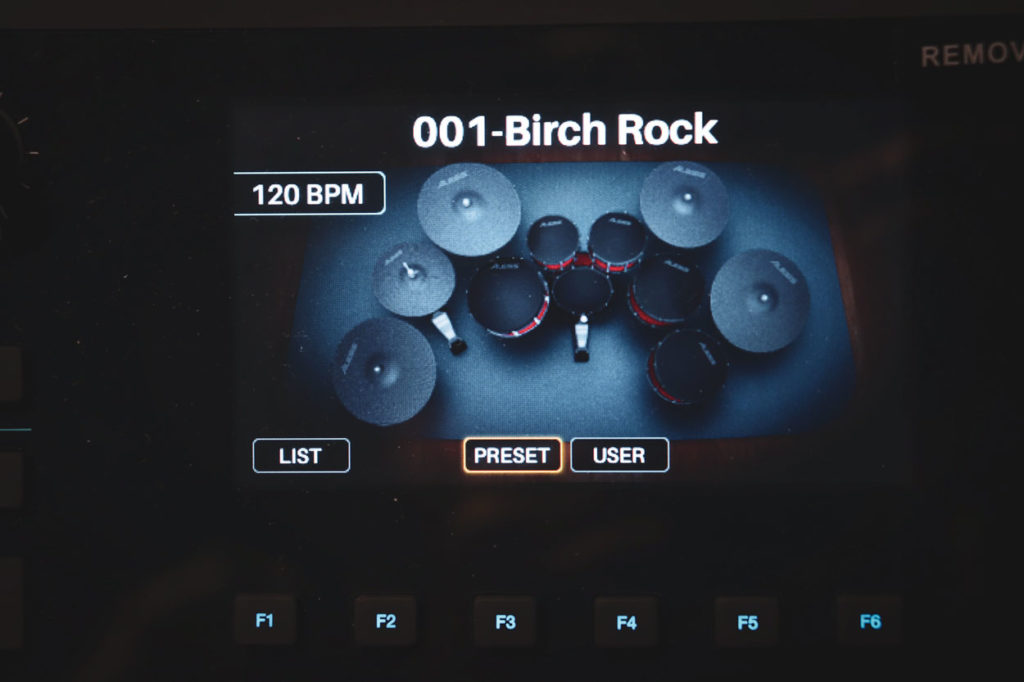
The LCD display looks great and shows a nice visual representation of each kit you are on with information about the preset. It’s very responsive and think that it’s actually better looking than the TD-50’s display.
Roland seems to be sticking with the old if it’s not broke, don’t fix it mentality on their modules, but I love the visual design and look of the display.
Ins and outs
The drum module comes with an 8GB SD card which you can load new samples and sounds onto. The USB/MIDI connections are great if you have the desire to use virtual instruments as I mentioned with a DAW.
The pads are connected to the module via the provided snake cable with each end labeled with colors to each respective pad.
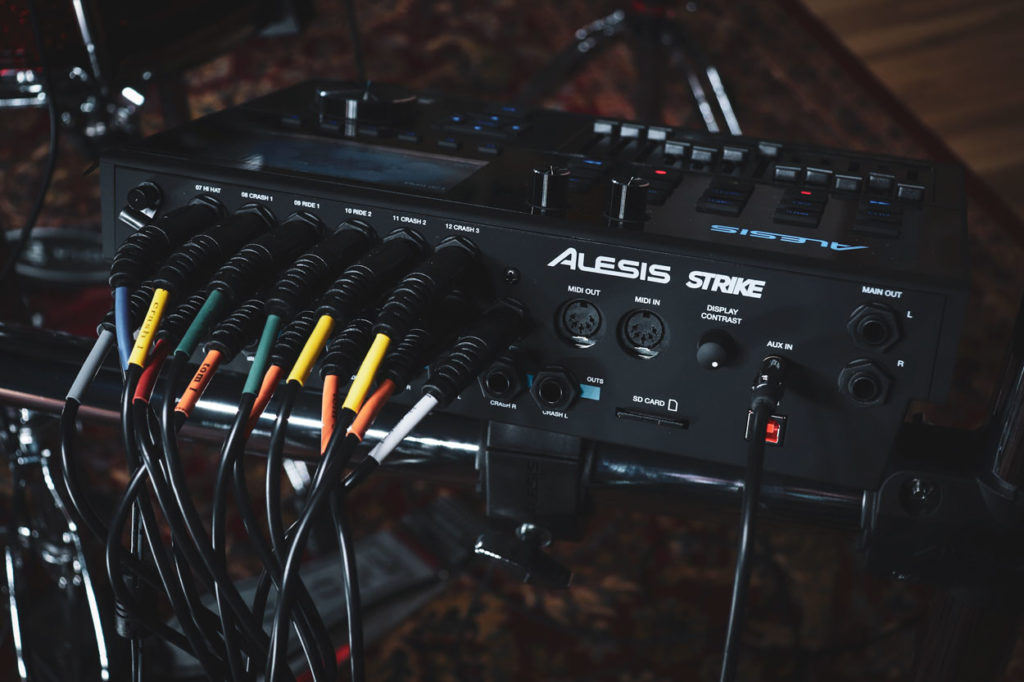
Alesis has also released the Strike Software Editor, which allows you to easily create new kits on your computer, rather than using the knobs on the module.
The sounds
For starters, you get 110 new drum kit presets made from 1,600 multi-sample instruments.
Out of all the kits available on the market, the Strike gets very close to accurately representing the dynamic range. Things like rolls and drags sound pretty good when compared to their entry-level siblings.
I’m pretty critical when it comes to the sound of mostly all electronic drum sets. In fact, I usually hate most of them. This is because I have recorded drums and also have used plenty of sample libraries when producing music.
Have a listen to some of the presets below taken from my module:
There is no EQ, compression, or other effects added to these recordings. These samples are straight off of the module into my Apollo Twin interface. You can hear a little bit of the hi-hat misfiring on the first sample.
Most of the kick and tom samples are acceptable to my ears, but the snares and cymbals aren’t the greatest. I have created my own custom kit that I rather enjoy, based off of the Power Station Natural preset.
The FX engine could be better
One flaw I have found is the inability to add compression and EQ to individual drums or cymbals. In my case, I’d like to compress the cymbals a bit harder, but not the snare at the same time.
You can only apply these effects to the entire kit, as FX1 and FX2 have useless effects like flanger and wah-wah. Unless I am doing something wrong, I don’t believe it’s possible.
Modules don’t often have the best sounds anyway
I would much prefer using virtual drum libraries (VSTs) with electronic kits, as mentioned before. Using VSTs isn’t the most straightforward task by any means, so it is relieving when you can have an out-of-the-box solution for great drum sounds.
External VST instruments are NOT easy to use with the Strike module
The Strike Pro is rather tricky to use with VST drum libraries. While I eventually did get the mappings to line up correctly, there is no way for the software to differentiate between the open and closed hi-hat midi CC messages.
I have read many support threads on forums with many users dealing with the same problem.
What is the deal here, Alesis? Are we ever going to see a fix?
One of my primary reasons for purchasing the Strike kit was to have the ability to record drums in a quiet setting. It is absolutely frustrating trying to make this kit work properly.
Most drum modules don’t sound great to my ears, including the Strike and even the TD-50. That being said, these two modules are what I would consider acceptable. I promise I’m done being an audio snob.
Pros of the Strike Pro
- Affordable when compared to Roland drums
- Incredible look and feel
- Solid and sturdy chrome rack
- Decent sounding module
Being that Pro is in the name, this kit is targeted at the professional-level consumer. If you’re a first
I love the look and feel of the kit overall. It gives me all the features of a top-level electronic kit at a big fraction of the price. The solid chrome rack, which I haven’t mentioned yet, is also very durable and looks great.
The sound quality is subjective, being how snobby I am about it, but I’m able to look past this since it is an electronic kit after all.
Alesis has packed a lot of professional features into a kit that is just under $2,500.
Cons of the Strike Pro
- Quality assurance problems with hi-hat and piezos
- Limited effects engine
- Not a dedicated audio interface
- Expansion is somewhat limited
There are two giant issues with the Strike kit. The hi-hat controller reportedly has failed for many users. Symptoms of the problem include the pedal firing erratically, double triggering, not triggering at all, and other issues. The other issue being faulty piezo plates.
The hi-hat problems
The support forum linked above does list several strategies to fix the problem, but you shouldn’t have to rely on a DIY solution to a problem that should be completely fixed by now.
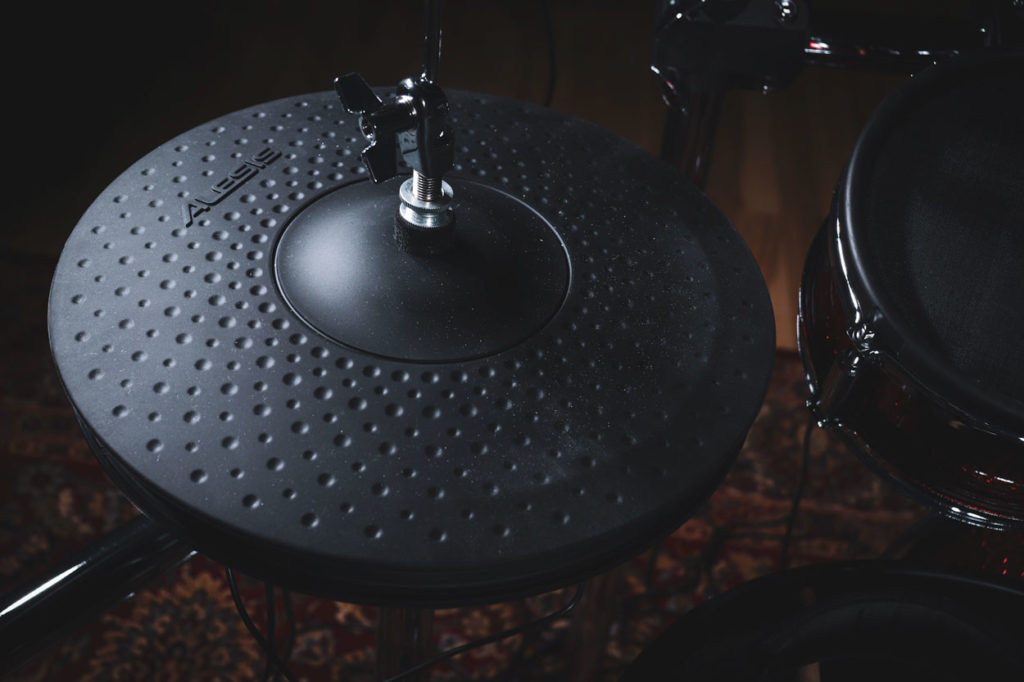
Upon setting up my kit, I had problems with the hi-hat instantly. The edge controller is very strange, often not responding to hits. Opening and closing the hi-hat often doesn’t work.
If they haven’t already, Alesis should send users of the faulty hi-hat a new controller pad that is fixed.
The 1.4 firmware update reportedly fixes many of the issues with the hi-hat but users (including myself) are still having to rig their controllers up with additional washers to fix the responsiveness problems.
The update improved my hi-hat triggering, but not by much. I managed to change some settings in the menu but haven’t completely alleviated the issue.
Faulty piezo plates
Update: since writing about the issues with the piezo plates and foam cylinders, I learned that I have a Generation 2 Strike kit, which supposedly fixes all of the issues below! I will update the article when and if I have problems!
Inside each drum pad lies a set of rubber cylinders that make contact with the mesh head and a plastic plate connected to the piezo. The adhesive used with these cylinders can come loose resulting in them falling over, causing poor triggering.

The pie
Experienced users of the Strike have begun using shipping tape to provide support to the plate and extend its life. Cut two pieces of tape in half and form a plus sign over the plate.

I’m hoping
Frequently asked questions
- Can I upgrade to the Strike Pro from the regular kit? Yes. You can definitely upgrade from the regular model to the Pro with Alesis’s expansion kit.
- Can I add more drum pads? Due to the fact that all the pads are dual-zone, technically it would be possible, though you would lose the dual-zone functionality.
- Does the kit come with a hi-hat stand, kick pedal, or throne? No, you will need to supply your own hi-hat stand, throne, and kick pedal.
- Are the mesh drum heads replaceable? Yes. You’ll need to reach out to Alesis’s parts team at parts@inmusicbrands.com. I suggest following the steps I’ve outlined to extend the duration of your kit.
- Can I use a double kick pedal with the Strike? Yes, the kick drum pad is very large and can support a double kick pedal.
Alternatives to the Strike Pro
If the hi-hat issue’s got you worried, there’s a couple options we can suggest instead.
If you’re already looking at the Strike Pro line from Alesis, I don’t think it’s wise to move down the ladder to their other products; if you happen to be looking for something a bit more affordable, the DM10 MKII or the Surge Mesh may be an okay option if you’re cool with no dedicated hi-hat stand.
The Roland TD-50KV also comes to mind, but it’s far more expensive than the Strike kit. Yamaha also makes the DTX562K at a similar price point to the Strike, but the module isn’t the greatest.
That being said, both of these kits also don’t have wooden shells and larger drum sizes.
The verdict
I have confidence that Alesis will continue to work on the quality control issues that the Strike Pro faces. If that problem is eliminated, this kit would score a near 100 rating.
I love the kit and the price point. I think it sounds moderately decent and definitely competes with Roland’s higher-end kits. I couldn’t recommend it more.
I don’t suggest you buy the kit if you’re a beginner. You need to decide for yourself if drums is going to be an obsession prior to dropping a lot on an electronic drum kit.
Over to you now. Do you have any experience with the Alesis Strike Pro? I’d love to hear from you down below in the comments. Thanks for reading. Bye for now.
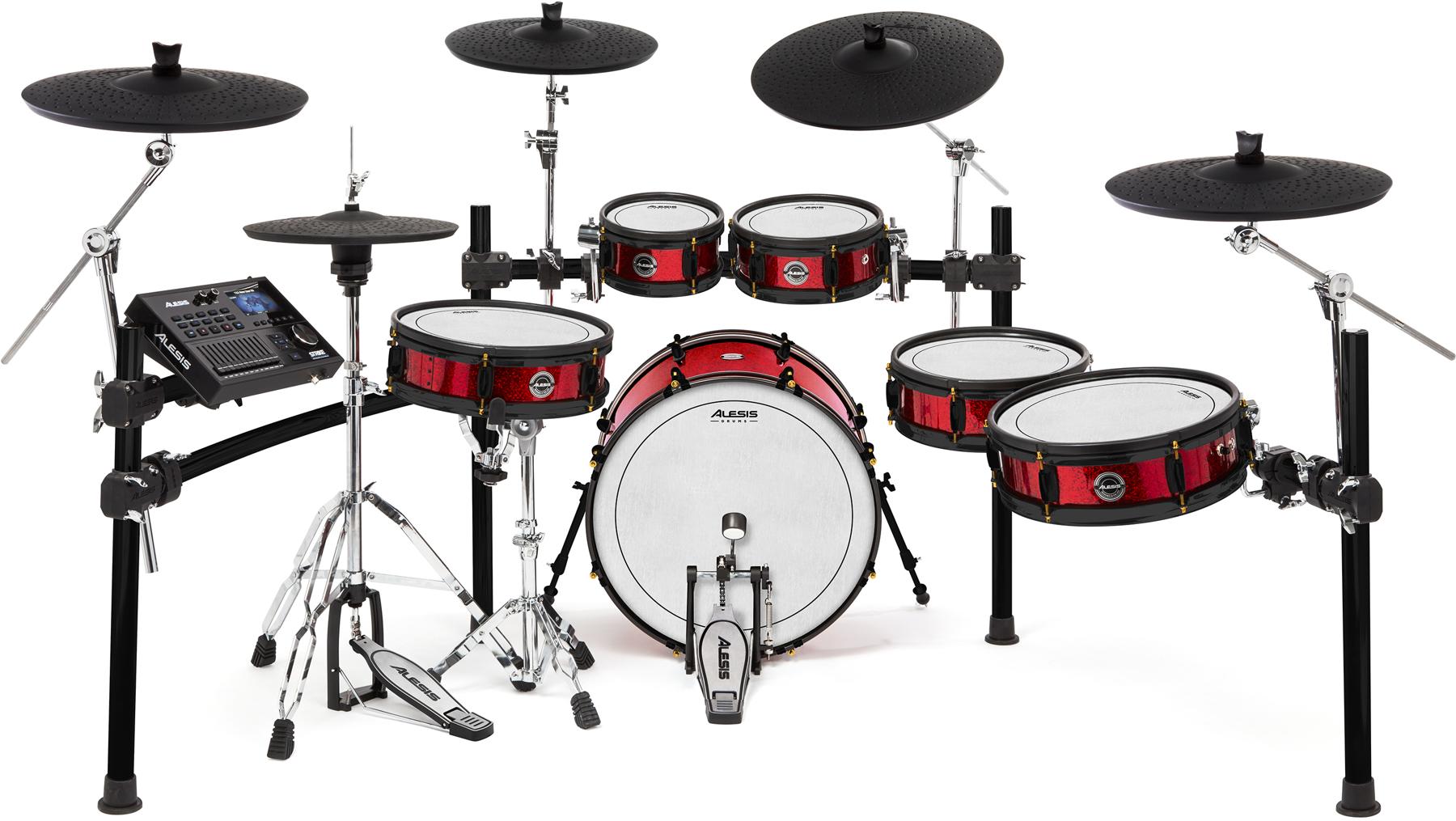

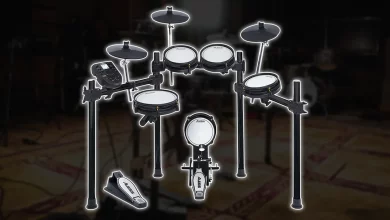
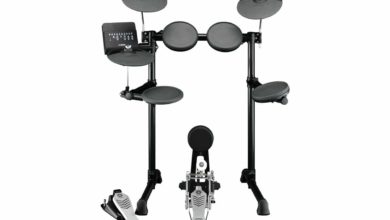
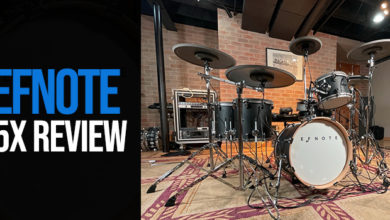
DO NOT BUY. I am an owner, and I have had nothing but issues. I am a lifelong drummer and have owned many e-kits. This is by far the worst quality I have ever seen in a drum kit. The cymbals stopped triggering within a few months, and the module has been replaced once already and is now, as of today, non functional. I wasted 2500$ on this kit, wish I had bought yamaha or roland, they have better quality and workmanship. This strike pro kit has been a disaster. DO NOT BUY, you have been warned 🙂
0
Alesis is slower, lets say 15 milliseconds (which I doubt compared to the Roland TD20 and Pearl Mimic Pro faster than Two hundred fifty-sixth note at 60 BPM. If the old Roland TD20 was 5-10 milliseconds and people were fine with it then the slightly slower speed on Alesis Strike should not be an issue.
0
Aloha Nick and Mahalo for the incredible review on the Alesis Pro Strike kit. I purchased my kit in May and have slowly transitioned from 40 years of acoustic kits to finally making the jump to full electronic. Overall i love the ease and sound of the kit. Although the Pandemic has changed the landscape for live music ( I live on Oahu, Hawaii) my band continues to perform and were actually quite busy. The best part of your review included a part that affected my gig just this last Saturday pertaining to the rubber cylinders inside the drum shells specifically the snare. It would trigger at certain points. Imagine my stress level once this started happening. I thought maybe I hadn’t plugged all the cables in properly although the sound check I did earlier found no issues. Of course doing a soundcheck is not the same as a performance exertion wise. Luckily we only had a 1 hour show but still it was terrifying not knowing what was happening. It did feel as if something was moving under the head but would then re-adjust itself. I do plan to open it up and tape down that plate but your review didn’t mention a fix for those rubber cylinders. I’m thinking possibly tightening down the head snuggly. We do 80s covers ( Journey, Styx Bon Jovi, GNR) so some of it requires more exertion . As I said your review was outstanding and overall I love my kit but now realize I have to learn little tricks to make sure the set responds the way I need it to.
0
Hey Roven!
Thank you for your kind words regarding my review! I am glad you are enjoying the kit and getting to practice more often. Always a plus.
It’s too bad you’re having an issue with your snare drum. Have you opened it up to take a look yet? My guess is that it is those rubber cylinders giving you issue.
I would try to identify what kind of adhesive they used during manufacturing and use something similar to re-apply any of them that have fallen off the plate. Super glue or maybe a hot-glue gun, though, I would worry about the heat potentially.
I went ahead and searched online for replacement parts for the Strike Pro, but unfortunately, no one seems to be selling them. It might be good to pick up a few extra rubber cylinders just in case one of them tears during the repair process.
You may have to contact Alesis directly and see what they can do. I remember hearing about someone who contacted Alesis and they just sent them a brand new snare.
Hope that helps!
Nick
0
Mahalo Nick. I will open the snare up tonight and take a look. I’m considering using acoustic cymbals with a real snare but I want to investigate further. The snare is the key which is hit continuously compared to the toms so critical in a gig situation. I just love the sound and options the drums provide. Aloha!
0
Nick I removed the head and all rubber cylinders are intact. What is that knob near the cable port? It seems to have a center notch but I’ve yet to figure out what it is. As you can see, I’m learning as I go and will probably temporarily until I get a better handle on this kit return to acoustic drums for future shows. Mahalo Nick really appreciate your help your obviously well versed on this kit.
0
That’s good news! At least they are all intact. The knob near the cable port handles sensitivity, if I remember correctly. Here’s a video that demonstrates: https://www.youtube.com/watch?v=S-o7Ush2dSE
I could never settle on a setting I liked, so I ended up leaving it at the default position. As far as exertion goes, you should be able to play pretty hard on the kit without worrying. Of course, I have a hard time doing so, as well. Electronic kits just feel a little more delicate than their acoustic counterparts.
0
And Nick what is the protocol with exertion? With acoustic drums you tend to put more pressure on the drums but what about the Alesis? I feel as if playing them the same way is what allowed the cylinders to move and not trigger. Just my opinion. Are they meant to be played “softer” or will hitting them the same way as acoustics actually give you more bang for the buck. Thanks.
0
I am saving for the Pro now, because as of 2021 it seems MOST problems are fixed (the HH being the main one for me).
I feel that for playing an e-kit you DO have to change your technique, just because it is a different animal. If you go form an acoustic set with, say 22-14-13-16 sizes to a smaller jazzy kit with 18-14-12-14 sizes you would also have to change your playing velocity because the smaller size drums would choke-out if you hit too hard……this is just an IMHO.
When I play my e-kit I KNOW I have to change technique, so it is really no big deal….if they are to low in volume, just turn them up! LOL! I wish sometimes I could do that with my acoustic kit……
0
Roven, just switch out the 14”Tom with the snare. No ?
0
HI. Great article. Hoping you can point me in the right direction. I have a hybrid Roland setup using the old TD-20 expanded module. What are your thoughts on getting the Alesis Strike module for a replacement to the TD20? I’m trying not to spend lots of money, but get the best bang for my buck. I don’t gig with it. Maybe play it a few times a week. Or if you have another module in mind, I’d appreciate some feedback on that. Thanks, Ron
0
Thanks for the great review, Nick… very helpful! I purchased the new strike pro se kit and am really enjoying it. One thing I noticed is that you can’t trigger the rim and head of a drum simultaneously… I.e, rimshot. Wondering if you know of a setting that would allow this. I know it can be emulated with layering, but it’s not quite the same.
Any help would be great!
Thanks!
0
Thanks for the great review. Long time drummer here as well. One issue I encountered with my Strike Pro SE was the mesh kick drum head. I use a DW double kick pedal and nowhere in the setup info does it say anything about which side of the beater to use. I had the felt side to the drum head and within a month of moderate use it punched a hole in the head due to friction. Replaced with a new mesh head and turned the beater heads around. We’ll see how it goes. Thanks –
0
THIS! I hope I mentioned this in the article. It’s super important to use the plastic side of the kick beater on mesh pads. Thanks for the comment Jeff!
0
Hi Nick, great review. I played for about 15 years, stopped for about 15 years and I’m now getting back into drumming, finally. I’m used to having two high hats, one to my left with foot control and then just a static slightly open one to my right. Do you know of anybody that uses this setup? Can I use just a regular symbol to mimic a slightly open hi-hat?
0
Welcome back! You definitely can change the sound of one of the crash cymbals to be an open hi-hat. Most drum modules are capable of this. With some setups, you might even be able to add an additional hi-hat, but you might need to be on the Roland TD-50 module to achieve this.
0
I recently sold my 7 yr old TD-50 for the price I bought it for. I have had this strike pro SE for 2 days and I’m sending it back. All I want is a realistic feeling kit for trigger GGD or other plug-ins in Logic. I have had no luck getting logic to recognize this kit and from what I can gather online, it’s a major problem. Also, Alesis has not updated the software to work with Mac in over 2 years. So, the software editor is not available from “Big Sur OS” and up. Pretty ridiculous and frustrating. I would have never bought it, if I knew this. Think I’ll pick up the EFnote kit. Kit feels amazing, but the back end of it is still very much a toy compared to Roland.
0
Nick, Can this be setup for us southpaws?
0
I think you’ll be fine, but I don’t think the module can display a mirrored version of the kit. Alesis should add a left-handed mode.
0
2024-01, Any updates regarding HH issues mentioned above being resolved by Alesis?
Looking as possible solution because of VAD pricing being what it is.
0